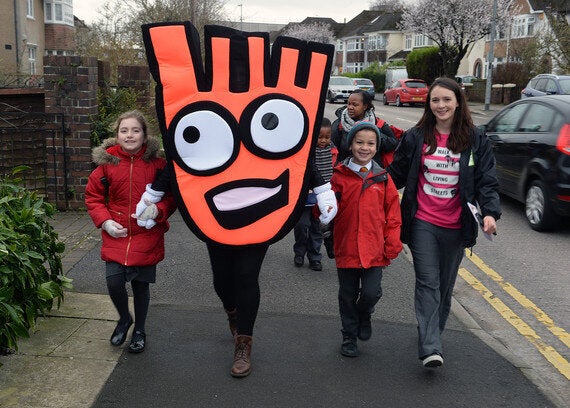Great news. We have come 5th in the WOW campaign...top ten this week for the percentage of children who walk to school.
This was a tweet from Redwell Primary School on Wednesday, celebrating their success in getting their pupils walking to school more. It's what we like to hear and it's why we do what we do.
October is International Walk to School Month - not a date many of us will have in our diary but as walking to school rates hits a dangerous low point and child health problems increase, maybe it should be.
Nowadays, less than half of primary age children walk to school in England and Scotland; it's only slightly more in Wales. But a generation ago 70 per cent of us walked to school. Why does this matter?
Here are a couple of big reasons. A shocking fifth of our 10 year olds are now clinically obese. 16 years ago there had never been a single case of a child being diagnosed with type 2 diabetes in the UK. This week, BBC's Panorama revealed that there are now more than 500 cases in the UK. Diabetes is estimated to cost the NHS £10 billion a year- and rising. Eating better and keeping active are a big part of the solution.
At Living Streets, we've always promoted walking to school as an easy way for children to get more active. It's a journey they're making every day anyway, so let's make it an active one. We're not the only ones seizing on the potential of the walk to school to create a healthier nation.
Walking to school was highlighted as a priority in the Government's recent Obesity Strategy for England. In Wales the Active Travel Act obliges local authorities to plan walking and cycling routes. And in Scotland it is a feature of the national walking strategy. More countries around the world are taking this seriously.
In fact, in the lead up to International Walk to School Month, we spoke with organisations around the globe working to encourage more children to walk to school. We found an all too common trend of increasing car use and decreasing walking rates met with a rise in childhood obesity. In Canada just 33 per cent of children walk to school, although that's more than double Australia's 15 per cent.
We heard a few reasons from our international counterparts as to why children are walking less: busy routines, traffic and weather all featured. And we also heard possible solutions. In Canada they host 'Winter Walk Days', where hot chocolate is offered to walkers who brave the colder days. In New Zealand, electronic speed signs change during school run hours to instruct drivers to reduce their speeds, easing the worries of parents about road safety.
At Living Streets, we know that catchment areas can be an issue for some families in the UK, so we promote Park and Stride - swapping school gate gridlock for parking further away and taking a short walk instead. It means children can still get active - boosting their mental and physical health - and it stops the school being surrounded by traffic and harmful air pollution.

Image: School children in Bristol get involved with Park and Stride
Research we carried out last year found that over half of families who don't walk to school would like to but are put off by a range of reasons. Overcoming those obstacles is the key to improvement. If we could bring in the half who would like to walk, that would be an extra 25 per cent of children walking to school. That's a lot of healthier and happier children. So, as well as asking for more reasons as to why they're not walking, we asked our supporters for solutions.
The majority of responses were around making the walk to school more exciting and engaging: games to play on the way and rewards for those who stick to it. And we certainly know this works. WOW - our year-round walk to school challenge rewards children with collectable badges and increases the number of children walking to school by 23 per cent on average. Some respondents went right to the top, calling for vehicle exclusions zones, lower speed limits and changes to the school selection process. If you have more ideas, we'd love to hear them. I urge you to think about the obstacles to walking and seek a solution.
If you think your child's school could benefit from incentivising children then speak to teachers about our walk to school challenge trial pack. If you have concerns about safety around your school, talk to your head teacher, local authority or MP. And if you could park further away and walk the last stretch then the school could speak to a nearby supermarket, pub or church about allowing their car park to be used by parents for Park and Stride.
Childhood obesity, soaring diabetes and harmful air pollution mean we can't afford excuses anymore. We need solutions. Give some of them a go and join families across the world walking to school this October.

Image: Children around the world are celebrating International Walk to School Month (Picture courtesy of Green Communities Canada)